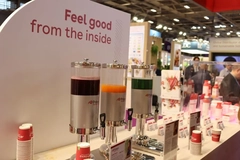UPF texture: The Restructure Project’s innovative approach to tackling diet-related diseases

16 Aug 2024 --- The Restructure Project aims to expand the current knowledge of how ultra-processed food (UPF) affects human health by exploring the effects of texture on our diet choices. The team, comprised of experts from the European Food Information Council, the Netherlands’ HAS University of Applied Sciences and Wageningen University, aims to address metabolic health issues through evidence-based food design principles.
“Several studies have shown that diets high in UPFs are associated with overweight and obesity and diet-related chronic diseases such as type 2 diabetes and coronary heart disease,” notes the Restructure Project team. “However, to date it is unknown what aspects of UPF drive this effect on calorie overconsumption and health.”
They note that previous research has also shown that food texture (e.g., liquid, soft, hard, elastic, etc.) and energy density (the number of calories contained in 100 g of food) are two of the most important food properties that drive excessive calorie consumption.
“Energy density affects how much calories people consume as people tend to eat a fixed amount or portion of a specific food, not adjusting for the amount of energy it may contain.”
One example they give is that if a person consumes a bowl of yogurt each morning when served a more caloric type of yogurt, they will eat the same volume they are used to rather than adjusting to the same amount of calories.
“Certain food textures require less chewing before a bite of food can be swallowed and are therefore faster to eat,“ the team points out. For example, 1 kg of grapes takes the average person 19 minutes to consume, while the same amount of grapes squeezed into juice takes just 1.5 minutes to drink.
Previous research has shown that the speed of eating affects the speed at which we feel full, which in turn determines how much food we eat during a meal. When food is eaten quickly, people tend to eat more. The texture of UPF may, therefore, play an important role in driving food or calorie overconsumption of these foods.”
 Studies show diets high in UPFs are associated with overweight, obesity and diet-related chronic diseases.Texture impacts speed of eating
Studies show diets high in UPFs are associated with overweight, obesity and diet-related chronic diseases.Texture impacts speed of eating
The Restructure Project research is being carried out in two stages. The first involves a literature review to generate guidance on which food properties reduce the speed of eating and the amount of food eaten. Mathematical models will be used to predict the eating rate or energy intake rate based on the “textural parameters” for different food groups.
Eating rate is defined as the eating speed (measured in g/min and kcal/min).
“Studies show that eating slowly can reduce energy intake (the amount of calories consumed),” the researchers underscore. “Eating rate depends on macronutrient composition and food structure and processing.”
The second stage is the intervention trial, which seeks to investigate how food texture influences food and energy intake. The 40 participants will be given two distinct, two-week diets. One diet will include UPFs with textures thought to induce a fast-eating rate (e.g., sugar-sweetened yogurt) and the other a slow-eating rate (e.g., meatballs).
Both groups will receive large amounts of food and instructed to eat as much or as little as they like, until they feel comfortably full. After the initial 14-day period, the groups will be asked to switch diets to the opposite.
The research team is now calling for clinical trial registration and the pre-data analysis scripts and detailed study methods have been made available to the public.
Effects on health
The aim of the trial will be to determine how UPF consumption may be linked to higher energy intakes, metabolic functions and changes in body weight.
One of the specific health markers that the trial will test is body composition measures, namely weight, lean muscle mass, fat mass and water retention.
 Food texture and energy density play an important role in driving excessive calorie consumption.The other is acute metabolic health markers: glucose and insulin responses after eating a meal, satiety hormone responses and energy expenditure.
Food texture and energy density play an important role in driving excessive calorie consumption.The other is acute metabolic health markers: glucose and insulin responses after eating a meal, satiety hormone responses and energy expenditure.
Lastly, the trial will look at prolonged metabolic health markers, such as continuous glucose monitoring of long-term satiety hormones in the blood and gut microbiome and urine markers of metabolic health.
“By shedding light on how the composition and texture-properties influence eating rate, Restructure will produce the criteria to define ‘slow foods’ and the principles that can be used to guide their development.”
The research team acknowledges that definitions of UPFs may vary. They describe such foods as “formulations of ingredients, mostly of exclusive industrial use, that result from a series of industrial processes (hence ‘ultra-processed’).”
“The Restructure trial will determine whether the effects of texture on energy intake rate are independent of being classified as ultra-processed foods.”
The outcomes of the Restructure Project are expected to be made available in early 2025, but the team asserts its desire to provide ongoing information about the study type, blinding procedures, study design and randomization methods employed as the trial is carried out. They hope that such transparency will encourage the scientific community to scrutinize the research protocol and provide feedback.
Meanwhile, scientists at the US Fralin Biomedical Research Institute at Virginia Tech Carilion created a tool to assess the properties that make UPFs so rewarding and addictive to consume.
By Milana Nikolova












